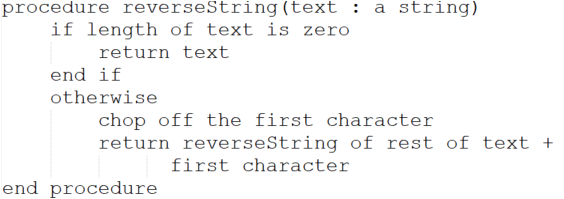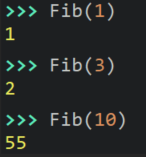Week 8 - Recursive Algorithms
Outcomes
You should be able to:
- Describe the three "laws" of recursion.
- Identify where each of the three "laws" of recursion are observed in a recursive algorithm.
- Identify the Big-oh runtime analysis for a recursive algorithm.
Activities
Getting Started
- Watch - What is this thing called recursion? [Video - 13 minutes]
- Watch - How recursion was used in Fractal Ferns [Video - 5 minutes]
- Watch - How recursion was used in the Sierpinski Triangle [Video - 5 minutes]
- Watch - How recursion was used in the Code.org Binary Search algorithm [Video - 8 minutes]
- Watch - How recursion was used in the textbook Binary Search algorithm (the better one in my opinion) [Video - 6 minutes]
Reading
- Section 4.2 - What is Recursion?
- Section 4.3 - Calculating the Sum of a List of Numbers
- Section 4.4. The Three Laws of Recursion
- Section 4.5. Converting an Integer to a String in Any Base
- Section 4.6. Stack Frames: Implementing Recursion
- Section 4.7. Visualizing Recursion
- Section 4.8. Sierpinski Triangle
- You may read 4.10 and 4.11 based on your interests
Some additional examples
- Writing/viewing a few recursive algorithms
- Watch - isPalindrome() [Video - 13 minutes]
- Finished Recursive Code
- Non-recursive algorithms using loops (two versions)
- Watch - Recursive Sudoku [Video - 13 minutes]
- Watch - isPalindrome() [Video - 13 minutes]
You Try It
In this activity I would like you (with a partner if you like) to try to use what you just learned to create recursive algorithms in python for:
- Finbonacci
- Recall that
the Fibonacci sequence is:
- 1,1,2,3,5,8,13,21,34,55,...
- The first two numbers are 1 and then
- Each number is the sum of the two numbers before it:
- Fib(n) = Fib(n-1) + Fib(n-2) when n ≥ 3
- Recall that
the Fibonacci sequence is:
- Write a function called Fib() that takes in a positive integer and returns the value at that position in the Fibonacci sequence. For example:
- NOTE: This algorithm is a classic one that teachers talk about to WRITE the algorithm because it is really short/simple. BUT, it is not an algorithm we woud ever "deploy" because it's runtime is O(2n) or exponential. Yes, you read that right O(2n) and not O(n2). Big difference.
- Even if you figure out how to write this algorithm, I encourage you watch the followup video below to see what I mean by this.
- Reverse a string
- One way to reverse a string is to understand that the first letter of the string needs to be moved to the back of the string
- And once you do that, you need to take what is left and move the first letter of THAT to the back of the sub-string
- and so on
- and so on

- For example:
You Try It Solutions
- Watch - My explanation for the Fib() code [Video - 4 minutes]
- recursive_finoacci.py - the code in that video
- Watch - My explanation about why recursive Fib() is O(2n) or Exponential and is AWFUL. [Video 6 minutes)
- Watch - My explanation of reverseString [Video - 4 minutes]

